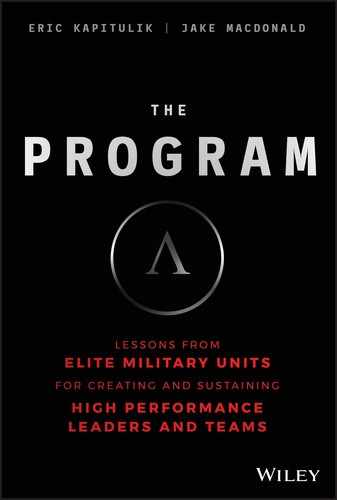2
Determining “Best”
THE PROGRAM HAS one mission: develop better leaders and create more cohesive teams. We help construct world-class organizations. World-class organizations have world-class cultures, and those cultures’ foundations are its “best” people. World-class organizations have world-class cultures, and those cultures’ foundations are its “best” people. “Best”, for any organization, occurs at the overlap in the Venn diagram shown in Figure 2.1. One circle represents the organization’s Core Values (more on this in Chapter 3) and the other represents talent. The “best” person for any organization is one who embodies that team’s Core Values, and who is also incredibly talented. In the short term, talent helps a team accomplish its mission. Its culture, as defined by its Core Values, combined with talent, ensures that team’s long-term ability to do so. Figure 2.1 The best people for your organization have talent and share your organization’s core values. In order to lay the foundation of a Championship Culture, the question we must first answer is not what we want our organizations to stop doing, but rather how we want them to start behaving. As the leader, we do this by first determining our Core Values. One of the first lessons all Marine Corps officers are taught (although not all learn it) is never to ask our Marines to do something that we aren’t willing to do ourselves. More importantly, don’t ask them to be someone that we aren’t willing to be also. It is a mistake, however, that almost all of us make. A coach tells players to clean up their messy locker room but the coach’s office is even dirtier. Business leaders demand that their employees follow the organization’s credit card policy, but then turn around and use their own for all sorts of questionable purchases. Closer to home, how many parents have told their children that they need to “get outside their comfort zone,” but haven’t done so themselves in the past month—or the past five years? As leaders of athletic teams, schools, businesses, and our own families, let’s be better than this. We should never ask our people to do something—or more importantly, to be someone—we aren’t willing to be ourselves. If we expect our team to behave in a disciplined manner (and hence one of our team’s Core Values is Discipline), then as the leaders, we must behave in a disciplined manner, as well. When determining our team’s Core Values, we must determine what the non- negotiable traits are that we, as the leaders, embody and expect our team to embody, as well. Unfortunately, too many leaders make the mistake of enforcing, and then reinforcing, the behaviors they don’t want, rather than asking themselves what the behaviors are that they do. Let’s not make this same mistake. When determining desired behaviors, start by thinking about what do we, as leaders, stand for? What do we represent? What does it mean (or what do we want it to mean) to be a member of our team? The answers to these questions are our Core Values. Parents, the head coach, or the CEO set the Core Values for the family, team, or business, respectively. We appreciate that leaders, at times, will join companies that may already have Core Values. However, if those Core Values are not already those of the new CEOs, division managers, or employees, then it will not be a good fit for the new hire, regardless of position within the organization. However, for teams without Core Values, or for teams who realize that theirs must change, there are numerous ways to determine what their Core Values should be, and as much time as possible should be spent doing so. The following diagram and exercise illustrates one way The Program does so with our own clients. Rick Van Arnam, former U.S. Army Colonel and principal consultant at the Table Group, first provided this exercise to us. He also offered a wealth of information surrounding Core Values, based on his work with Patrick Lencioni, who had recently published The Advantage: Why Organizational Health Trumps Everything Else in Business (Jossey-Bass, 2012). It should be mandatory reading for any leader.
A second method of determining Core Values is simply to think about the adjectives that best describe you. Ask the people who know you best (spouse, partner, parent, best friend) to do the same for you. Ultimately, as the leader, what are the values that you embody and that you want your team to embody as well? What are the values that are most important to you?
Determining Core Values
